BX2081 Consumer Behavior Report: Nescafe Milano Coffee Machine
VerifiedAdded on 2022/12/12
|17
|3704
|228
Report
AI Summary
This report critically evaluates the consumer decision-making process for the Nescafe Milano coffee machine, exploring the key factors influencing consumer behavior and consumption. It begins with an introduction outlining the report's purpose, data sources, and limitations. The report then delves into the purchase situation, analyzing the product service and consumer decision-making model, including the involvement level and risks associated with the purchase. It profiles the target market using demographic, behavioral, and psychographic variables. The core of the report focuses on the factors influencing consumer behavior, distinguishing between external factors like cultural, social, psychological, and economic influences, and internal factors such as need recognition, information search, and evaluation of alternatives. The report concludes with recommendations based on the analysis and a summary of the findings, offering insights into how marketers can effectively influence consumer choices in the coffee machine market. The report follows the structure outlined in the assignment brief, including an introduction, product/service description, target market profile, analysis of influencing factors, and recommendations. The report uses the provided content to analyze the consumer decision-making process.
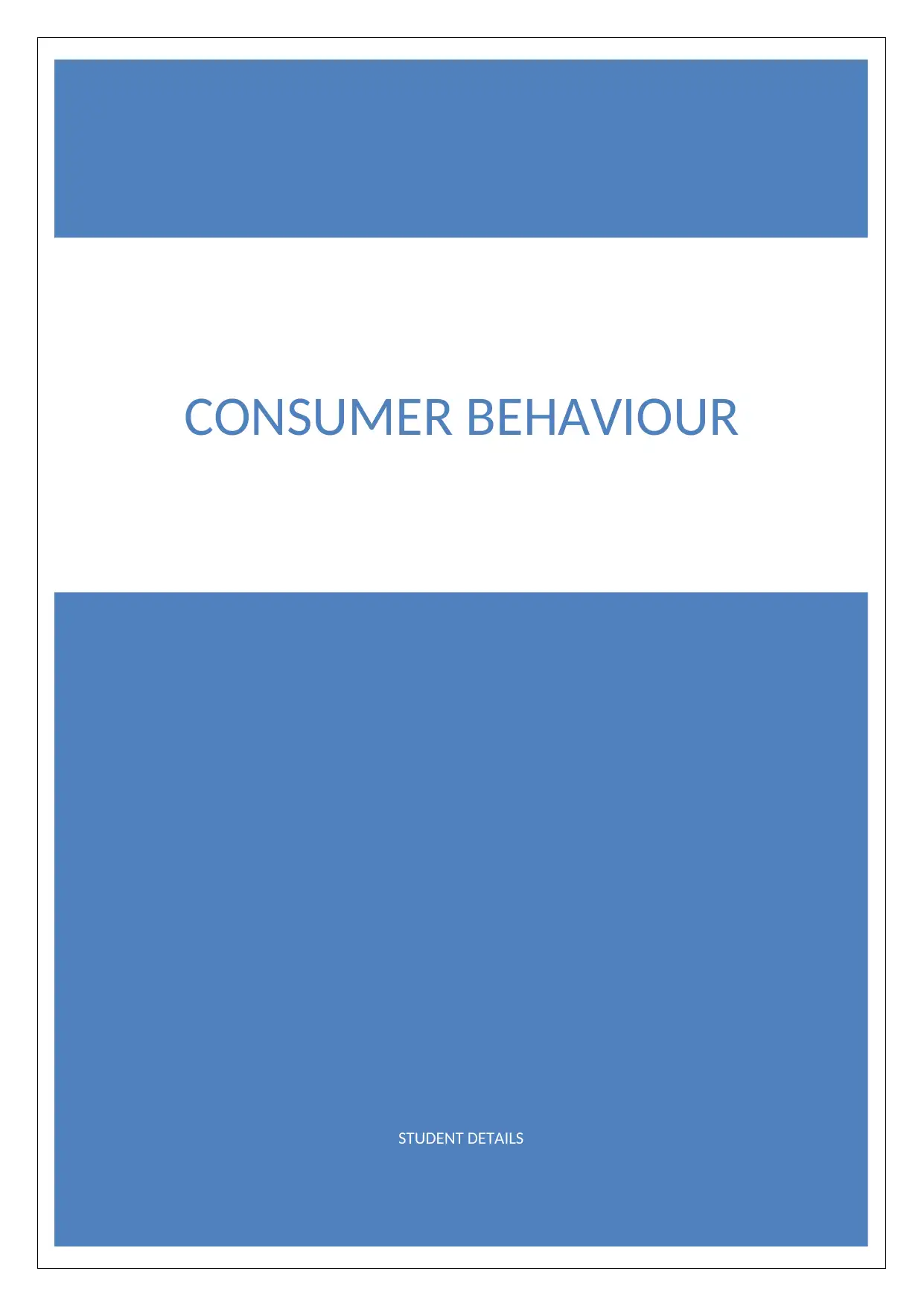
STUDENT DETAILS
CONSUMER BEHAVIOUR
CONSUMER BEHAVIOUR
Paraphrase This Document
Need a fresh take? Get an instant paraphrase of this document with our AI Paraphraser
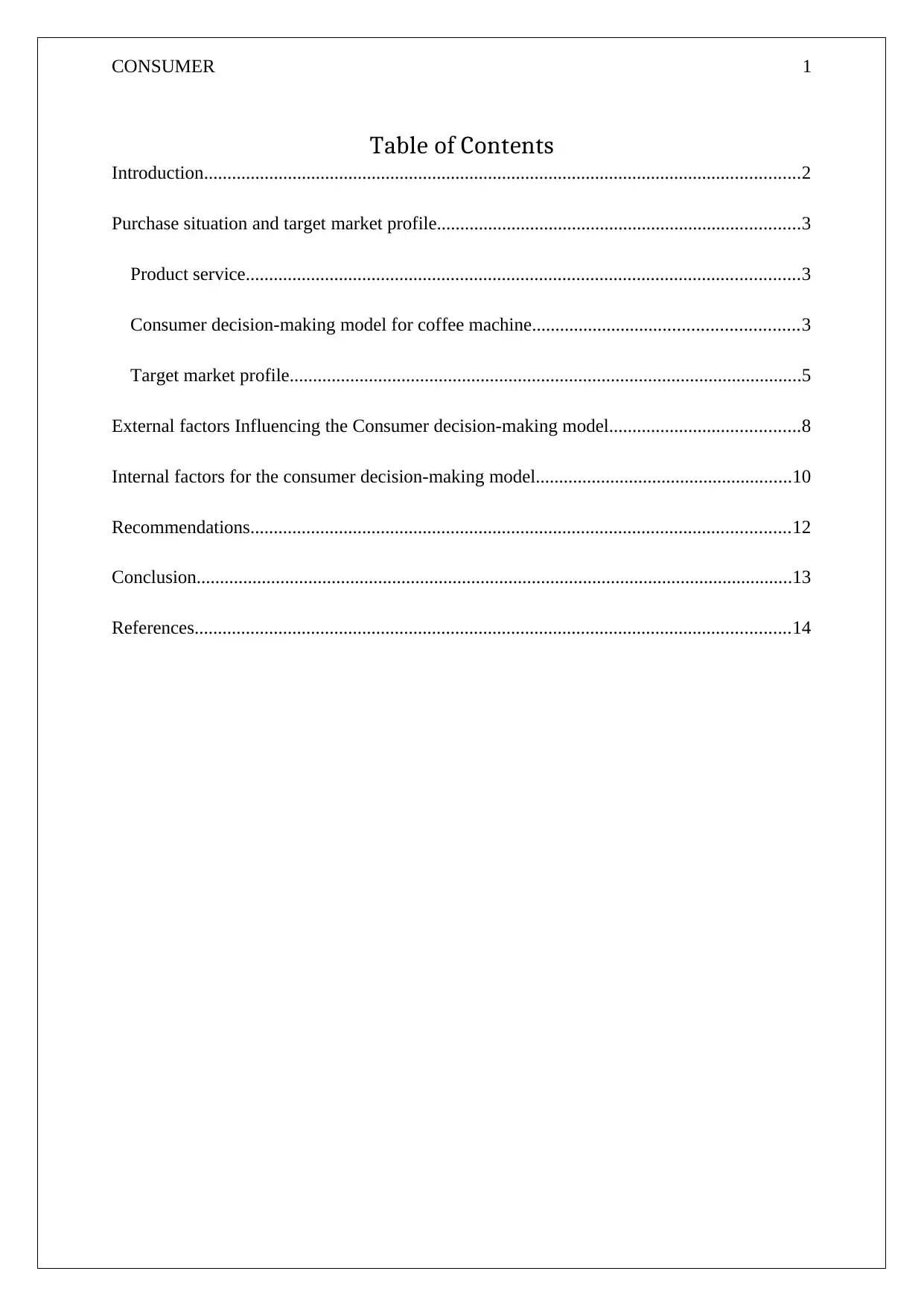
CONSUMER 1
Table of Contents
Introduction................................................................................................................................2
Purchase situation and target market profile..............................................................................3
Product service.......................................................................................................................3
Consumer decision-making model for coffee machine.........................................................3
Target market profile..............................................................................................................5
External factors Influencing the Consumer decision-making model.........................................8
Internal factors for the consumer decision-making model.......................................................10
Recommendations....................................................................................................................12
Conclusion................................................................................................................................13
References................................................................................................................................14
Table of Contents
Introduction................................................................................................................................2
Purchase situation and target market profile..............................................................................3
Product service.......................................................................................................................3
Consumer decision-making model for coffee machine.........................................................3
Target market profile..............................................................................................................5
External factors Influencing the Consumer decision-making model.........................................8
Internal factors for the consumer decision-making model.......................................................10
Recommendations....................................................................................................................12
Conclusion................................................................................................................................13
References................................................................................................................................14
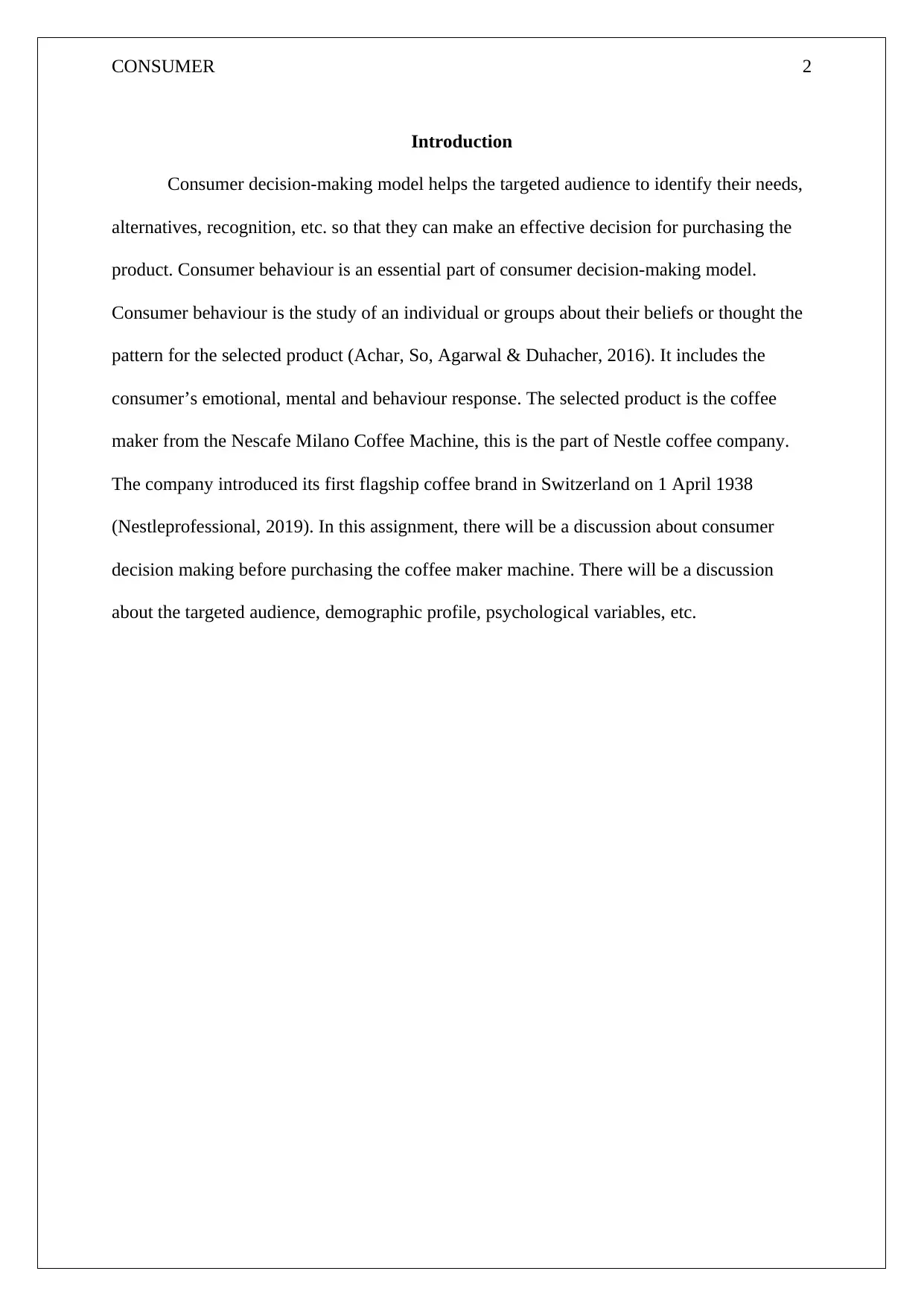
CONSUMER 2
Introduction
Consumer decision-making model helps the targeted audience to identify their needs,
alternatives, recognition, etc. so that they can make an effective decision for purchasing the
product. Consumer behaviour is an essential part of consumer decision-making model.
Consumer behaviour is the study of an individual or groups about their beliefs or thought the
pattern for the selected product (Achar, So, Agarwal & Duhacher, 2016). It includes the
consumer’s emotional, mental and behaviour response. The selected product is the coffee
maker from the Nescafe Milano Coffee Machine, this is the part of Nestle coffee company.
The company introduced its first flagship coffee brand in Switzerland on 1 April 1938
(Nestleprofessional, 2019). In this assignment, there will be a discussion about consumer
decision making before purchasing the coffee maker machine. There will be a discussion
about the targeted audience, demographic profile, psychological variables, etc.
Introduction
Consumer decision-making model helps the targeted audience to identify their needs,
alternatives, recognition, etc. so that they can make an effective decision for purchasing the
product. Consumer behaviour is an essential part of consumer decision-making model.
Consumer behaviour is the study of an individual or groups about their beliefs or thought the
pattern for the selected product (Achar, So, Agarwal & Duhacher, 2016). It includes the
consumer’s emotional, mental and behaviour response. The selected product is the coffee
maker from the Nescafe Milano Coffee Machine, this is the part of Nestle coffee company.
The company introduced its first flagship coffee brand in Switzerland on 1 April 1938
(Nestleprofessional, 2019). In this assignment, there will be a discussion about consumer
decision making before purchasing the coffee maker machine. There will be a discussion
about the targeted audience, demographic profile, psychological variables, etc.
⊘ This is a preview!⊘
Do you want full access?
Subscribe today to unlock all pages.

Trusted by 1+ million students worldwide
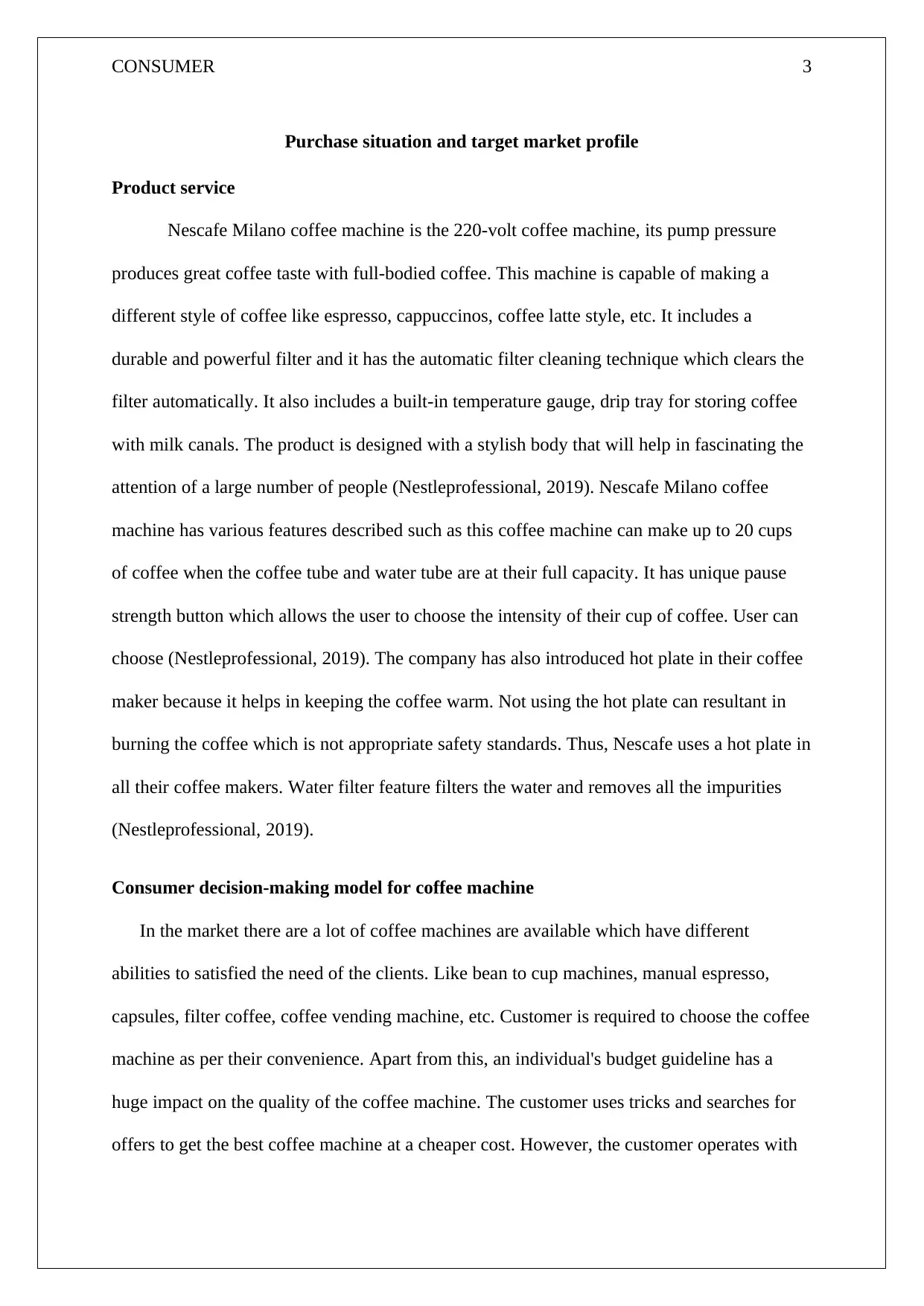
CONSUMER 3
Purchase situation and target market profile
Product service
Nescafe Milano coffee machine is the 220-volt coffee machine, its pump pressure
produces great coffee taste with full-bodied coffee. This machine is capable of making a
different style of coffee like espresso, cappuccinos, coffee latte style, etc. It includes a
durable and powerful filter and it has the automatic filter cleaning technique which clears the
filter automatically. It also includes a built-in temperature gauge, drip tray for storing coffee
with milk canals. The product is designed with a stylish body that will help in fascinating the
attention of a large number of people (Nestleprofessional, 2019). Nescafe Milano coffee
machine has various features described such as this coffee machine can make up to 20 cups
of coffee when the coffee tube and water tube are at their full capacity. It has unique pause
strength button which allows the user to choose the intensity of their cup of coffee. User can
choose (Nestleprofessional, 2019). The company has also introduced hot plate in their coffee
maker because it helps in keeping the coffee warm. Not using the hot plate can resultant in
burning the coffee which is not appropriate safety standards. Thus, Nescafe uses a hot plate in
all their coffee makers. Water filter feature filters the water and removes all the impurities
(Nestleprofessional, 2019).
Consumer decision-making model for coffee machine
In the market there are a lot of coffee machines are available which have different
abilities to satisfied the need of the clients. Like bean to cup machines, manual espresso,
capsules, filter coffee, coffee vending machine, etc. Customer is required to choose the coffee
machine as per their convenience. Apart from this, an individual's budget guideline has a
huge impact on the quality of the coffee machine. The customer uses tricks and searches for
offers to get the best coffee machine at a cheaper cost. However, the customer operates with
Purchase situation and target market profile
Product service
Nescafe Milano coffee machine is the 220-volt coffee machine, its pump pressure
produces great coffee taste with full-bodied coffee. This machine is capable of making a
different style of coffee like espresso, cappuccinos, coffee latte style, etc. It includes a
durable and powerful filter and it has the automatic filter cleaning technique which clears the
filter automatically. It also includes a built-in temperature gauge, drip tray for storing coffee
with milk canals. The product is designed with a stylish body that will help in fascinating the
attention of a large number of people (Nestleprofessional, 2019). Nescafe Milano coffee
machine has various features described such as this coffee machine can make up to 20 cups
of coffee when the coffee tube and water tube are at their full capacity. It has unique pause
strength button which allows the user to choose the intensity of their cup of coffee. User can
choose (Nestleprofessional, 2019). The company has also introduced hot plate in their coffee
maker because it helps in keeping the coffee warm. Not using the hot plate can resultant in
burning the coffee which is not appropriate safety standards. Thus, Nescafe uses a hot plate in
all their coffee makers. Water filter feature filters the water and removes all the impurities
(Nestleprofessional, 2019).
Consumer decision-making model for coffee machine
In the market there are a lot of coffee machines are available which have different
abilities to satisfied the need of the clients. Like bean to cup machines, manual espresso,
capsules, filter coffee, coffee vending machine, etc. Customer is required to choose the coffee
machine as per their convenience. Apart from this, an individual's budget guideline has a
huge impact on the quality of the coffee machine. The customer uses tricks and searches for
offers to get the best coffee machine at a cheaper cost. However, the customer operates with
Paraphrase This Document
Need a fresh take? Get an instant paraphrase of this document with our AI Paraphraser
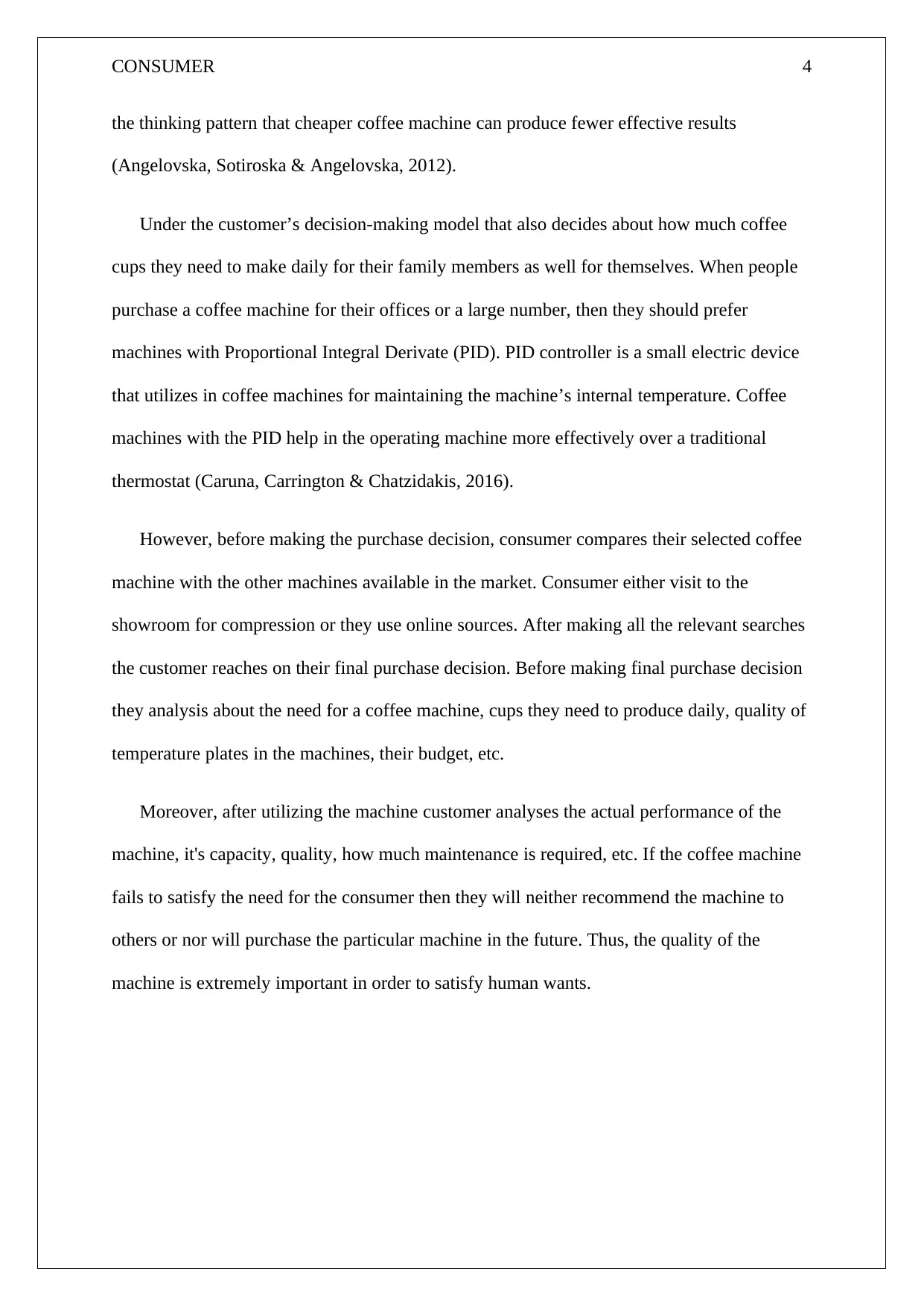
CONSUMER 4
the thinking pattern that cheaper coffee machine can produce fewer effective results
(Angelovska, Sotiroska & Angelovska, 2012).
Under the customer’s decision-making model that also decides about how much coffee
cups they need to make daily for their family members as well for themselves. When people
purchase a coffee machine for their offices or a large number, then they should prefer
machines with Proportional Integral Derivate (PID). PID controller is a small electric device
that utilizes in coffee machines for maintaining the machine’s internal temperature. Coffee
machines with the PID help in the operating machine more effectively over a traditional
thermostat (Caruna, Carrington & Chatzidakis, 2016).
However, before making the purchase decision, consumer compares their selected coffee
machine with the other machines available in the market. Consumer either visit to the
showroom for compression or they use online sources. After making all the relevant searches
the customer reaches on their final purchase decision. Before making final purchase decision
they analysis about the need for a coffee machine, cups they need to produce daily, quality of
temperature plates in the machines, their budget, etc.
Moreover, after utilizing the machine customer analyses the actual performance of the
machine, it's capacity, quality, how much maintenance is required, etc. If the coffee machine
fails to satisfy the need for the consumer then they will neither recommend the machine to
others or nor will purchase the particular machine in the future. Thus, the quality of the
machine is extremely important in order to satisfy human wants.
the thinking pattern that cheaper coffee machine can produce fewer effective results
(Angelovska, Sotiroska & Angelovska, 2012).
Under the customer’s decision-making model that also decides about how much coffee
cups they need to make daily for their family members as well for themselves. When people
purchase a coffee machine for their offices or a large number, then they should prefer
machines with Proportional Integral Derivate (PID). PID controller is a small electric device
that utilizes in coffee machines for maintaining the machine’s internal temperature. Coffee
machines with the PID help in the operating machine more effectively over a traditional
thermostat (Caruna, Carrington & Chatzidakis, 2016).
However, before making the purchase decision, consumer compares their selected coffee
machine with the other machines available in the market. Consumer either visit to the
showroom for compression or they use online sources. After making all the relevant searches
the customer reaches on their final purchase decision. Before making final purchase decision
they analysis about the need for a coffee machine, cups they need to produce daily, quality of
temperature plates in the machines, their budget, etc.
Moreover, after utilizing the machine customer analyses the actual performance of the
machine, it's capacity, quality, how much maintenance is required, etc. If the coffee machine
fails to satisfy the need for the consumer then they will neither recommend the machine to
others or nor will purchase the particular machine in the future. Thus, the quality of the
machine is extremely important in order to satisfy human wants.
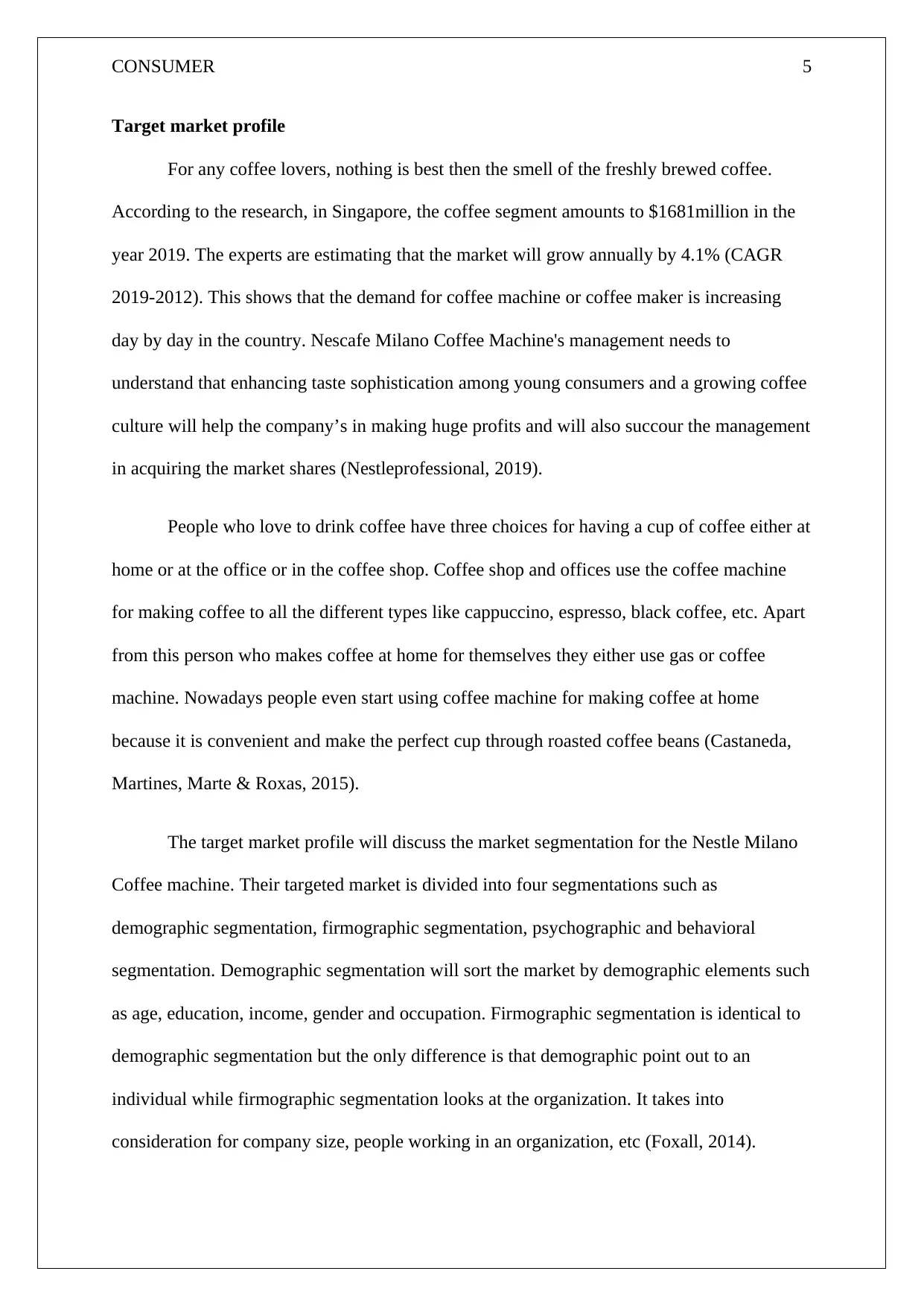
CONSUMER 5
Target market profile
For any coffee lovers, nothing is best then the smell of the freshly brewed coffee.
According to the research, in Singapore, the coffee segment amounts to $1681million in the
year 2019. The experts are estimating that the market will grow annually by 4.1% (CAGR
2019-2012). This shows that the demand for coffee machine or coffee maker is increasing
day by day in the country. Nescafe Milano Coffee Machine's management needs to
understand that enhancing taste sophistication among young consumers and a growing coffee
culture will help the company’s in making huge profits and will also succour the management
in acquiring the market shares (Nestleprofessional, 2019).
People who love to drink coffee have three choices for having a cup of coffee either at
home or at the office or in the coffee shop. Coffee shop and offices use the coffee machine
for making coffee to all the different types like cappuccino, espresso, black coffee, etc. Apart
from this person who makes coffee at home for themselves they either use gas or coffee
machine. Nowadays people even start using coffee machine for making coffee at home
because it is convenient and make the perfect cup through roasted coffee beans (Castaneda,
Martines, Marte & Roxas, 2015).
The target market profile will discuss the market segmentation for the Nestle Milano
Coffee machine. Their targeted market is divided into four segmentations such as
demographic segmentation, firmographic segmentation, psychographic and behavioral
segmentation. Demographic segmentation will sort the market by demographic elements such
as age, education, income, gender and occupation. Firmographic segmentation is identical to
demographic segmentation but the only difference is that demographic point out to an
individual while firmographic segmentation looks at the organization. It takes into
consideration for company size, people working in an organization, etc (Foxall, 2014).
Target market profile
For any coffee lovers, nothing is best then the smell of the freshly brewed coffee.
According to the research, in Singapore, the coffee segment amounts to $1681million in the
year 2019. The experts are estimating that the market will grow annually by 4.1% (CAGR
2019-2012). This shows that the demand for coffee machine or coffee maker is increasing
day by day in the country. Nescafe Milano Coffee Machine's management needs to
understand that enhancing taste sophistication among young consumers and a growing coffee
culture will help the company’s in making huge profits and will also succour the management
in acquiring the market shares (Nestleprofessional, 2019).
People who love to drink coffee have three choices for having a cup of coffee either at
home or at the office or in the coffee shop. Coffee shop and offices use the coffee machine
for making coffee to all the different types like cappuccino, espresso, black coffee, etc. Apart
from this person who makes coffee at home for themselves they either use gas or coffee
machine. Nowadays people even start using coffee machine for making coffee at home
because it is convenient and make the perfect cup through roasted coffee beans (Castaneda,
Martines, Marte & Roxas, 2015).
The target market profile will discuss the market segmentation for the Nestle Milano
Coffee machine. Their targeted market is divided into four segmentations such as
demographic segmentation, firmographic segmentation, psychographic and behavioral
segmentation. Demographic segmentation will sort the market by demographic elements such
as age, education, income, gender and occupation. Firmographic segmentation is identical to
demographic segmentation but the only difference is that demographic point out to an
individual while firmographic segmentation looks at the organization. It takes into
consideration for company size, people working in an organization, etc (Foxall, 2014).
⊘ This is a preview!⊘
Do you want full access?
Subscribe today to unlock all pages.

Trusted by 1+ million students worldwide
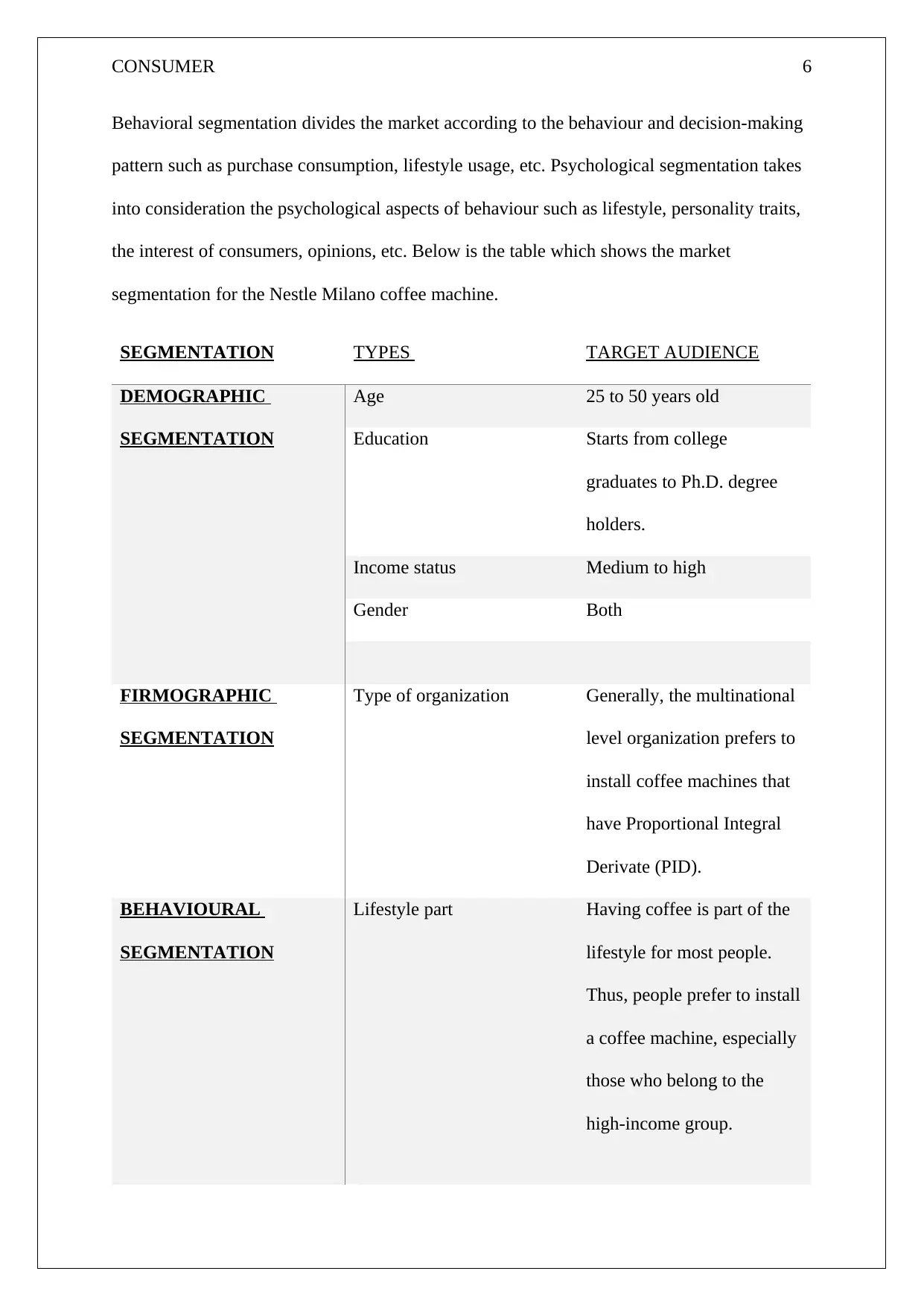
CONSUMER 6
Behavioral segmentation divides the market according to the behaviour and decision-making
pattern such as purchase consumption, lifestyle usage, etc. Psychological segmentation takes
into consideration the psychological aspects of behaviour such as lifestyle, personality traits,
the interest of consumers, opinions, etc. Below is the table which shows the market
segmentation for the Nestle Milano coffee machine.
SEGMENTATION TYPES TARGET AUDIENCE
DEMOGRAPHIC
SEGMENTATION
Age 25 to 50 years old
Education Starts from college
graduates to Ph.D. degree
holders.
Income status Medium to high
Gender Both
FIRMOGRAPHIC
SEGMENTATION
Type of organization Generally, the multinational
level organization prefers to
install coffee machines that
have Proportional Integral
Derivate (PID).
BEHAVIOURAL
SEGMENTATION
Lifestyle part Having coffee is part of the
lifestyle for most people.
Thus, people prefer to install
a coffee machine, especially
those who belong to the
high-income group.
Behavioral segmentation divides the market according to the behaviour and decision-making
pattern such as purchase consumption, lifestyle usage, etc. Psychological segmentation takes
into consideration the psychological aspects of behaviour such as lifestyle, personality traits,
the interest of consumers, opinions, etc. Below is the table which shows the market
segmentation for the Nestle Milano coffee machine.
SEGMENTATION TYPES TARGET AUDIENCE
DEMOGRAPHIC
SEGMENTATION
Age 25 to 50 years old
Education Starts from college
graduates to Ph.D. degree
holders.
Income status Medium to high
Gender Both
FIRMOGRAPHIC
SEGMENTATION
Type of organization Generally, the multinational
level organization prefers to
install coffee machines that
have Proportional Integral
Derivate (PID).
BEHAVIOURAL
SEGMENTATION
Lifestyle part Having coffee is part of the
lifestyle for most people.
Thus, people prefer to install
a coffee machine, especially
those who belong to the
high-income group.
Paraphrase This Document
Need a fresh take? Get an instant paraphrase of this document with our AI Paraphraser
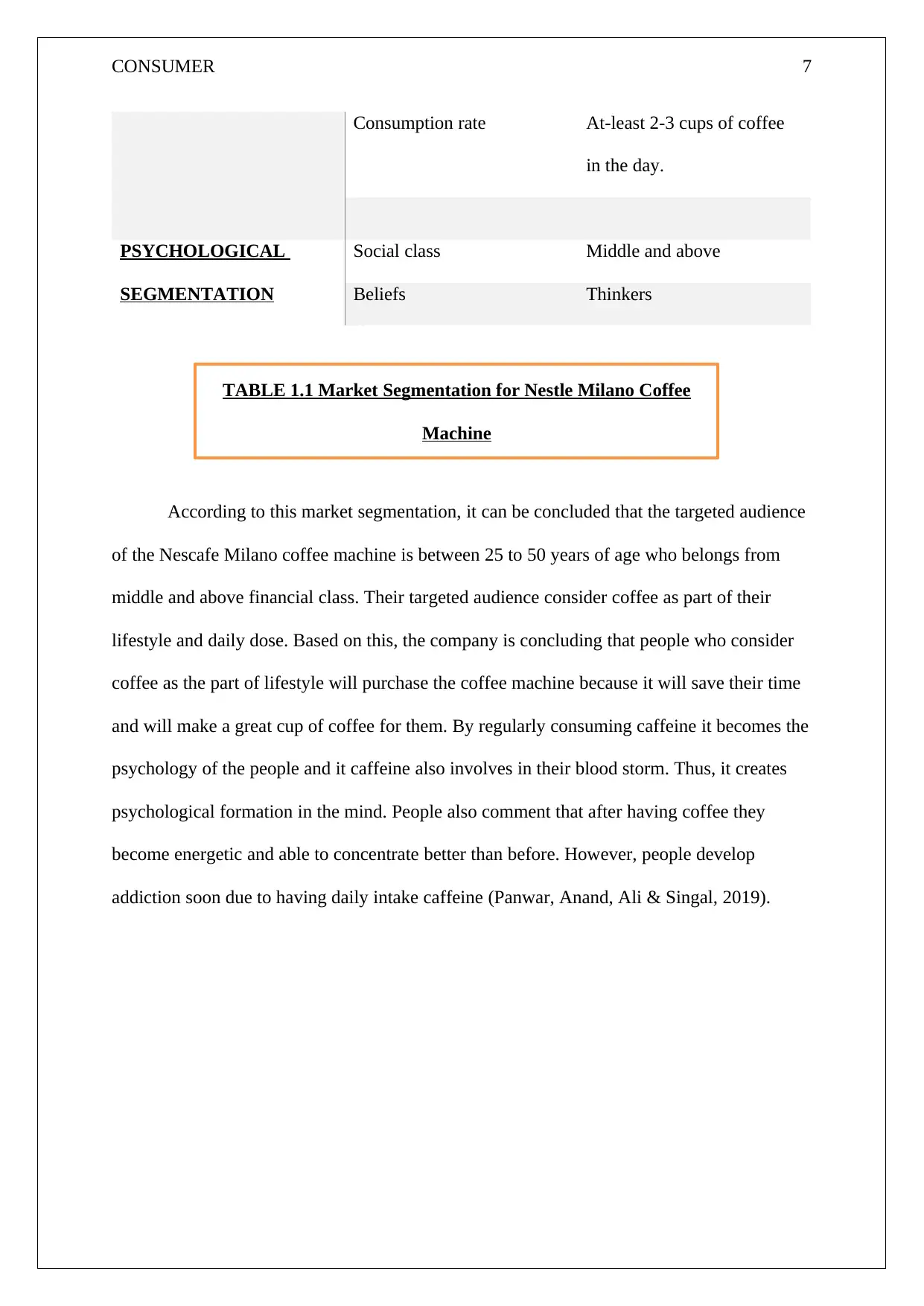
CONSUMER 7
Consumption rate At-least 2-3 cups of coffee
in the day.
PSYCHOLOGICAL
SEGMENTATION
Social class Middle and above
Beliefs Thinkers
According to this market segmentation, it can be concluded that the targeted audience
of the Nescafe Milano coffee machine is between 25 to 50 years of age who belongs from
middle and above financial class. Their targeted audience consider coffee as part of their
lifestyle and daily dose. Based on this, the company is concluding that people who consider
coffee as the part of lifestyle will purchase the coffee machine because it will save their time
and will make a great cup of coffee for them. By regularly consuming caffeine it becomes the
psychology of the people and it caffeine also involves in their blood storm. Thus, it creates
psychological formation in the mind. People also comment that after having coffee they
become energetic and able to concentrate better than before. However, people develop
addiction soon due to having daily intake caffeine (Panwar, Anand, Ali & Singal, 2019).
TABLE 1.1 Market Segmentation for Nestle Milano Coffee
Machine
Consumption rate At-least 2-3 cups of coffee
in the day.
PSYCHOLOGICAL
SEGMENTATION
Social class Middle and above
Beliefs Thinkers
According to this market segmentation, it can be concluded that the targeted audience
of the Nescafe Milano coffee machine is between 25 to 50 years of age who belongs from
middle and above financial class. Their targeted audience consider coffee as part of their
lifestyle and daily dose. Based on this, the company is concluding that people who consider
coffee as the part of lifestyle will purchase the coffee machine because it will save their time
and will make a great cup of coffee for them. By regularly consuming caffeine it becomes the
psychology of the people and it caffeine also involves in their blood storm. Thus, it creates
psychological formation in the mind. People also comment that after having coffee they
become energetic and able to concentrate better than before. However, people develop
addiction soon due to having daily intake caffeine (Panwar, Anand, Ali & Singal, 2019).
TABLE 1.1 Market Segmentation for Nestle Milano Coffee
Machine
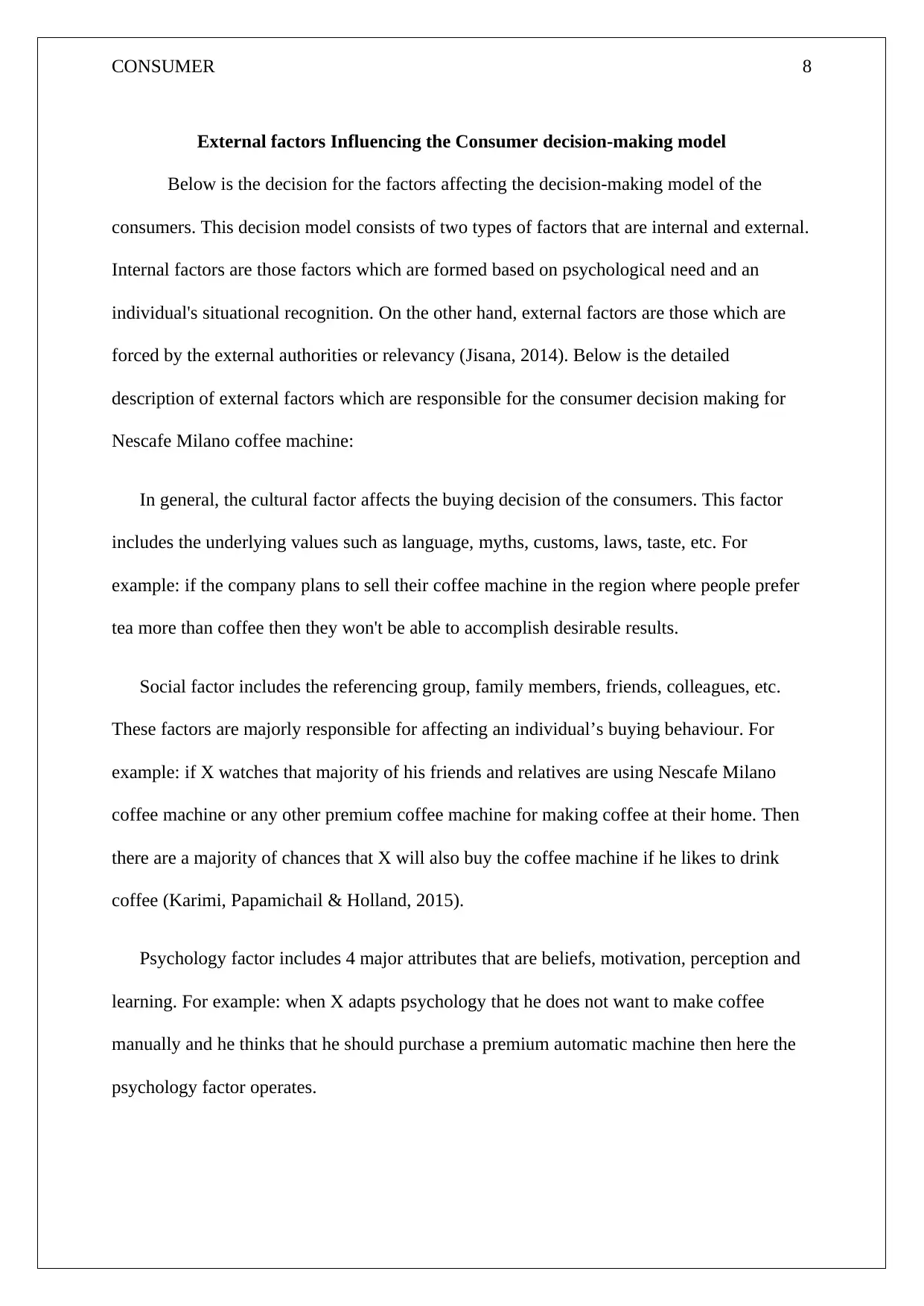
CONSUMER 8
External factors Influencing the Consumer decision-making model
Below is the decision for the factors affecting the decision-making model of the
consumers. This decision model consists of two types of factors that are internal and external.
Internal factors are those factors which are formed based on psychological need and an
individual's situational recognition. On the other hand, external factors are those which are
forced by the external authorities or relevancy (Jisana, 2014). Below is the detailed
description of external factors which are responsible for the consumer decision making for
Nescafe Milano coffee machine:
In general, the cultural factor affects the buying decision of the consumers. This factor
includes the underlying values such as language, myths, customs, laws, taste, etc. For
example: if the company plans to sell their coffee machine in the region where people prefer
tea more than coffee then they won't be able to accomplish desirable results.
Social factor includes the referencing group, family members, friends, colleagues, etc.
These factors are majorly responsible for affecting an individual’s buying behaviour. For
example: if X watches that majority of his friends and relatives are using Nescafe Milano
coffee machine or any other premium coffee machine for making coffee at their home. Then
there are a majority of chances that X will also buy the coffee machine if he likes to drink
coffee (Karimi, Papamichail & Holland, 2015).
Psychology factor includes 4 major attributes that are beliefs, motivation, perception and
learning. For example: when X adapts psychology that he does not want to make coffee
manually and he thinks that he should purchase a premium automatic machine then here the
psychology factor operates.
External factors Influencing the Consumer decision-making model
Below is the decision for the factors affecting the decision-making model of the
consumers. This decision model consists of two types of factors that are internal and external.
Internal factors are those factors which are formed based on psychological need and an
individual's situational recognition. On the other hand, external factors are those which are
forced by the external authorities or relevancy (Jisana, 2014). Below is the detailed
description of external factors which are responsible for the consumer decision making for
Nescafe Milano coffee machine:
In general, the cultural factor affects the buying decision of the consumers. This factor
includes the underlying values such as language, myths, customs, laws, taste, etc. For
example: if the company plans to sell their coffee machine in the region where people prefer
tea more than coffee then they won't be able to accomplish desirable results.
Social factor includes the referencing group, family members, friends, colleagues, etc.
These factors are majorly responsible for affecting an individual’s buying behaviour. For
example: if X watches that majority of his friends and relatives are using Nescafe Milano
coffee machine or any other premium coffee machine for making coffee at their home. Then
there are a majority of chances that X will also buy the coffee machine if he likes to drink
coffee (Karimi, Papamichail & Holland, 2015).
Psychology factor includes 4 major attributes that are beliefs, motivation, perception and
learning. For example: when X adapts psychology that he does not want to make coffee
manually and he thinks that he should purchase a premium automatic machine then here the
psychology factor operates.
⊘ This is a preview!⊘
Do you want full access?
Subscribe today to unlock all pages.

Trusted by 1+ million students worldwide
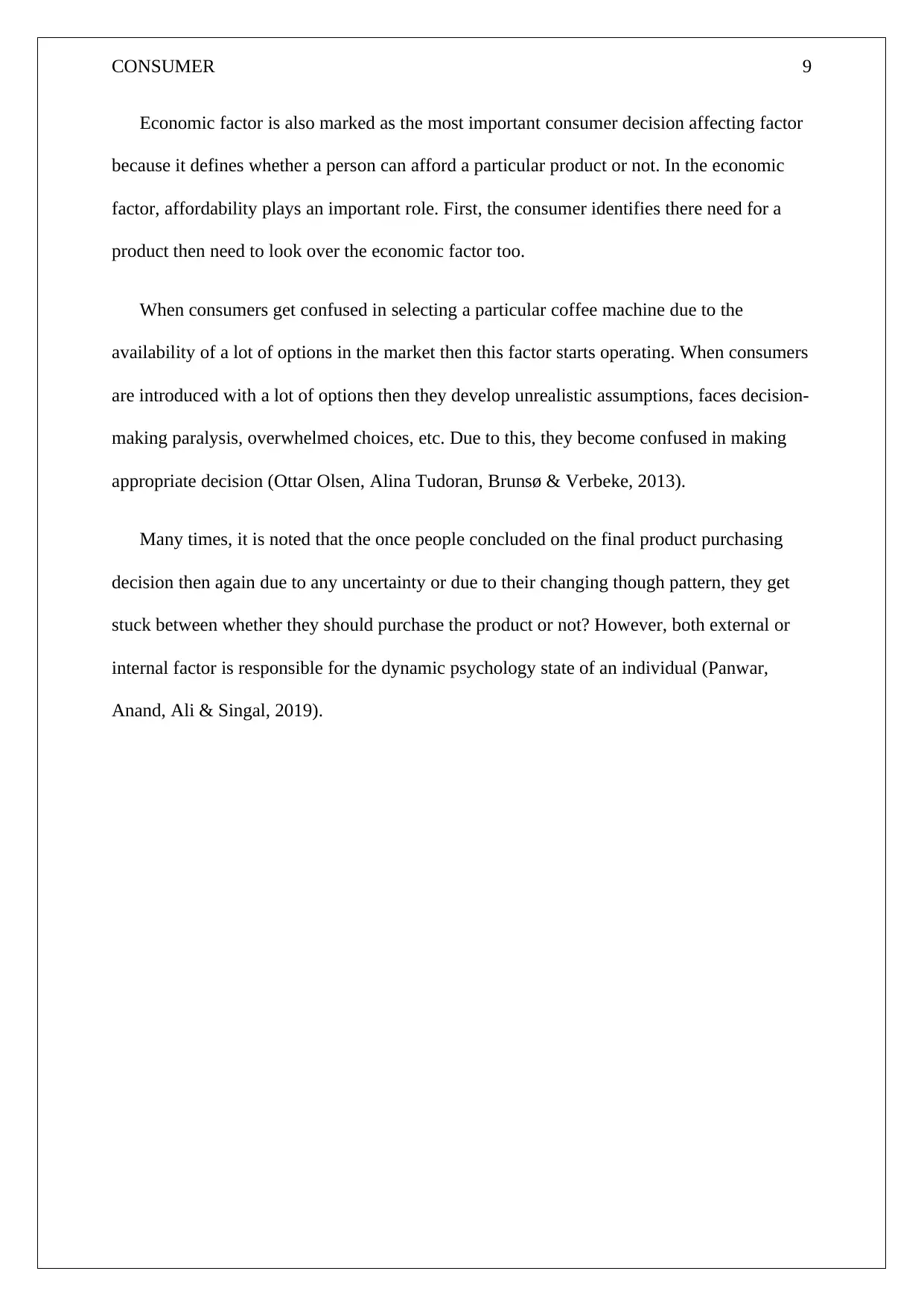
CONSUMER 9
Economic factor is also marked as the most important consumer decision affecting factor
because it defines whether a person can afford a particular product or not. In the economic
factor, affordability plays an important role. First, the consumer identifies there need for a
product then need to look over the economic factor too.
When consumers get confused in selecting a particular coffee machine due to the
availability of a lot of options in the market then this factor starts operating. When consumers
are introduced with a lot of options then they develop unrealistic assumptions, faces decision-
making paralysis, overwhelmed choices, etc. Due to this, they become confused in making
appropriate decision (Ottar Olsen, Alina Tudoran, Brunsø & Verbeke, 2013).
Many times, it is noted that the once people concluded on the final product purchasing
decision then again due to any uncertainty or due to their changing though pattern, they get
stuck between whether they should purchase the product or not? However, both external or
internal factor is responsible for the dynamic psychology state of an individual (Panwar,
Anand, Ali & Singal, 2019).
Economic factor is also marked as the most important consumer decision affecting factor
because it defines whether a person can afford a particular product or not. In the economic
factor, affordability plays an important role. First, the consumer identifies there need for a
product then need to look over the economic factor too.
When consumers get confused in selecting a particular coffee machine due to the
availability of a lot of options in the market then this factor starts operating. When consumers
are introduced with a lot of options then they develop unrealistic assumptions, faces decision-
making paralysis, overwhelmed choices, etc. Due to this, they become confused in making
appropriate decision (Ottar Olsen, Alina Tudoran, Brunsø & Verbeke, 2013).
Many times, it is noted that the once people concluded on the final product purchasing
decision then again due to any uncertainty or due to their changing though pattern, they get
stuck between whether they should purchase the product or not? However, both external or
internal factor is responsible for the dynamic psychology state of an individual (Panwar,
Anand, Ali & Singal, 2019).
Paraphrase This Document
Need a fresh take? Get an instant paraphrase of this document with our AI Paraphraser
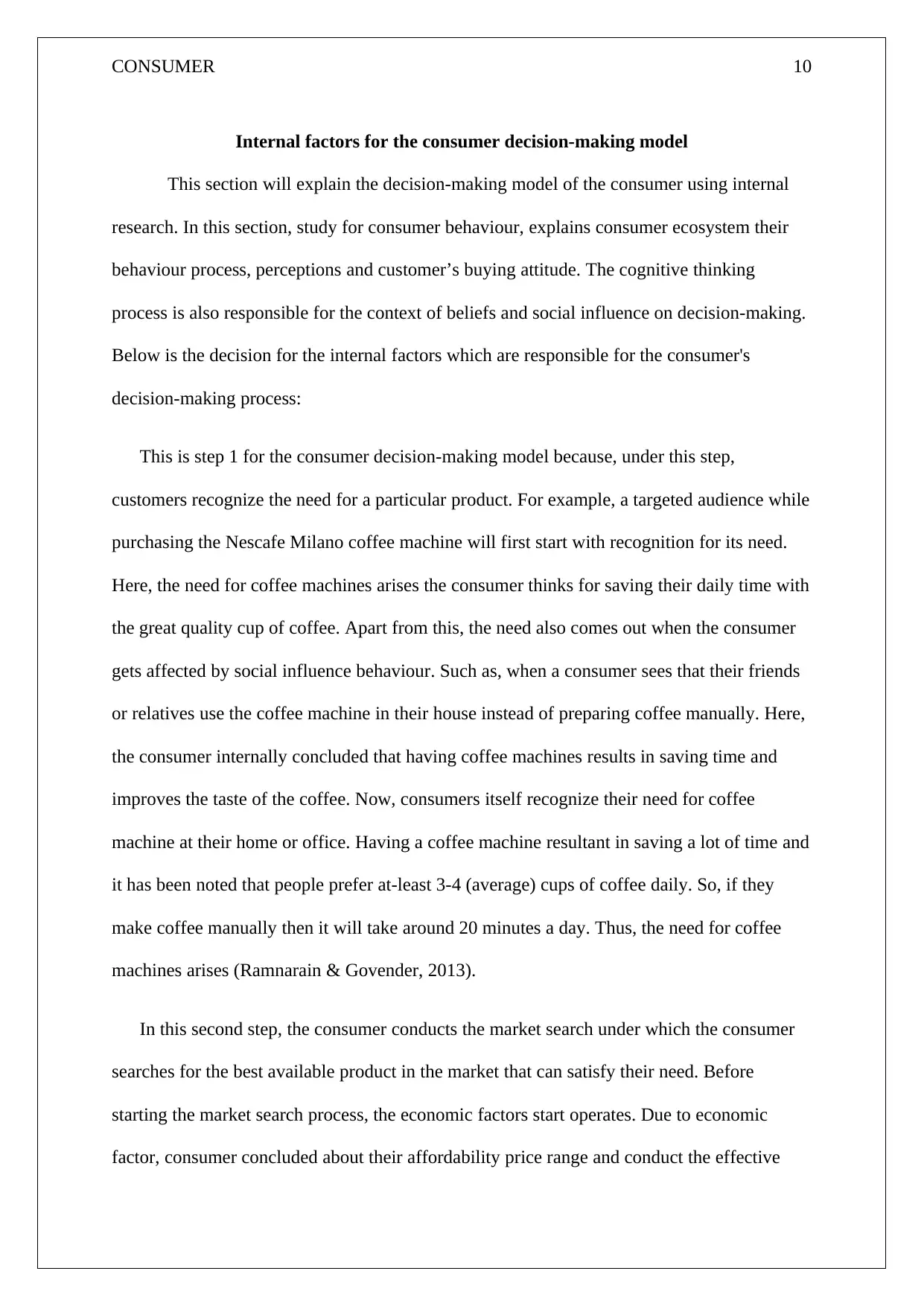
CONSUMER 10
Internal factors for the consumer decision-making model
This section will explain the decision-making model of the consumer using internal
research. In this section, study for consumer behaviour, explains consumer ecosystem their
behaviour process, perceptions and customer’s buying attitude. The cognitive thinking
process is also responsible for the context of beliefs and social influence on decision-making.
Below is the decision for the internal factors which are responsible for the consumer's
decision-making process:
This is step 1 for the consumer decision-making model because, under this step,
customers recognize the need for a particular product. For example, a targeted audience while
purchasing the Nescafe Milano coffee machine will first start with recognition for its need.
Here, the need for coffee machines arises the consumer thinks for saving their daily time with
the great quality cup of coffee. Apart from this, the need also comes out when the consumer
gets affected by social influence behaviour. Such as, when a consumer sees that their friends
or relatives use the coffee machine in their house instead of preparing coffee manually. Here,
the consumer internally concluded that having coffee machines results in saving time and
improves the taste of the coffee. Now, consumers itself recognize their need for coffee
machine at their home or office. Having a coffee machine resultant in saving a lot of time and
it has been noted that people prefer at-least 3-4 (average) cups of coffee daily. So, if they
make coffee manually then it will take around 20 minutes a day. Thus, the need for coffee
machines arises (Ramnarain & Govender, 2013).
In this second step, the consumer conducts the market search under which the consumer
searches for the best available product in the market that can satisfy their need. Before
starting the market search process, the economic factors start operates. Due to economic
factor, consumer concluded about their affordability price range and conduct the effective
Internal factors for the consumer decision-making model
This section will explain the decision-making model of the consumer using internal
research. In this section, study for consumer behaviour, explains consumer ecosystem their
behaviour process, perceptions and customer’s buying attitude. The cognitive thinking
process is also responsible for the context of beliefs and social influence on decision-making.
Below is the decision for the internal factors which are responsible for the consumer's
decision-making process:
This is step 1 for the consumer decision-making model because, under this step,
customers recognize the need for a particular product. For example, a targeted audience while
purchasing the Nescafe Milano coffee machine will first start with recognition for its need.
Here, the need for coffee machines arises the consumer thinks for saving their daily time with
the great quality cup of coffee. Apart from this, the need also comes out when the consumer
gets affected by social influence behaviour. Such as, when a consumer sees that their friends
or relatives use the coffee machine in their house instead of preparing coffee manually. Here,
the consumer internally concluded that having coffee machines results in saving time and
improves the taste of the coffee. Now, consumers itself recognize their need for coffee
machine at their home or office. Having a coffee machine resultant in saving a lot of time and
it has been noted that people prefer at-least 3-4 (average) cups of coffee daily. So, if they
make coffee manually then it will take around 20 minutes a day. Thus, the need for coffee
machines arises (Ramnarain & Govender, 2013).
In this second step, the consumer conducts the market search under which the consumer
searches for the best available product in the market that can satisfy their need. Before
starting the market search process, the economic factors start operates. Due to economic
factor, consumer concluded about their affordability price range and conduct the effective
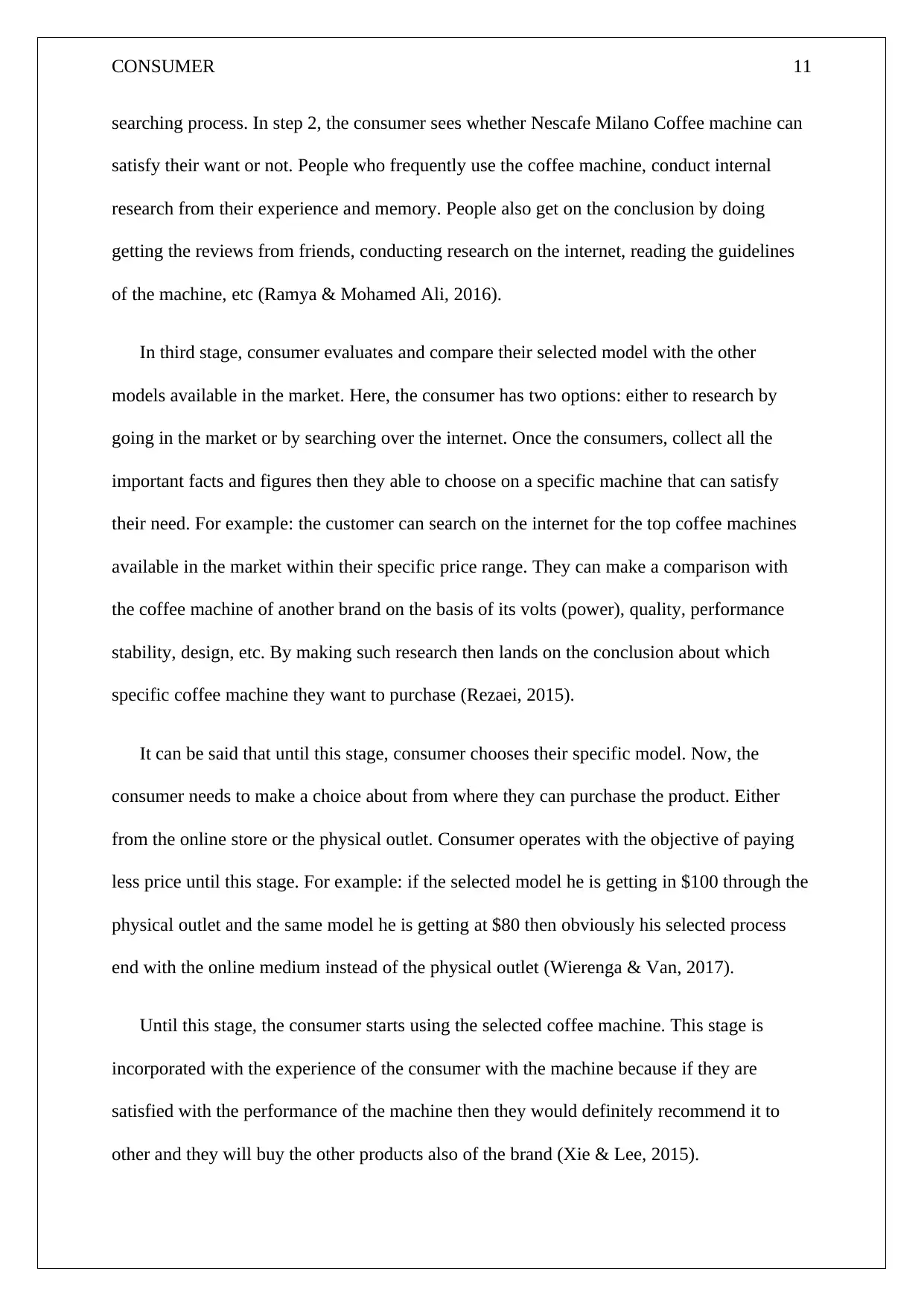
CONSUMER 11
searching process. In step 2, the consumer sees whether Nescafe Milano Coffee machine can
satisfy their want or not. People who frequently use the coffee machine, conduct internal
research from their experience and memory. People also get on the conclusion by doing
getting the reviews from friends, conducting research on the internet, reading the guidelines
of the machine, etc (Ramya & Mohamed Ali, 2016).
In third stage, consumer evaluates and compare their selected model with the other
models available in the market. Here, the consumer has two options: either to research by
going in the market or by searching over the internet. Once the consumers, collect all the
important facts and figures then they able to choose on a specific machine that can satisfy
their need. For example: the customer can search on the internet for the top coffee machines
available in the market within their specific price range. They can make a comparison with
the coffee machine of another brand on the basis of its volts (power), quality, performance
stability, design, etc. By making such research then lands on the conclusion about which
specific coffee machine they want to purchase (Rezaei, 2015).
It can be said that until this stage, consumer chooses their specific model. Now, the
consumer needs to make a choice about from where they can purchase the product. Either
from the online store or the physical outlet. Consumer operates with the objective of paying
less price until this stage. For example: if the selected model he is getting in $100 through the
physical outlet and the same model he is getting at $80 then obviously his selected process
end with the online medium instead of the physical outlet (Wierenga & Van, 2017).
Until this stage, the consumer starts using the selected coffee machine. This stage is
incorporated with the experience of the consumer with the machine because if they are
satisfied with the performance of the machine then they would definitely recommend it to
other and they will buy the other products also of the brand (Xie & Lee, 2015).
searching process. In step 2, the consumer sees whether Nescafe Milano Coffee machine can
satisfy their want or not. People who frequently use the coffee machine, conduct internal
research from their experience and memory. People also get on the conclusion by doing
getting the reviews from friends, conducting research on the internet, reading the guidelines
of the machine, etc (Ramya & Mohamed Ali, 2016).
In third stage, consumer evaluates and compare their selected model with the other
models available in the market. Here, the consumer has two options: either to research by
going in the market or by searching over the internet. Once the consumers, collect all the
important facts and figures then they able to choose on a specific machine that can satisfy
their need. For example: the customer can search on the internet for the top coffee machines
available in the market within their specific price range. They can make a comparison with
the coffee machine of another brand on the basis of its volts (power), quality, performance
stability, design, etc. By making such research then lands on the conclusion about which
specific coffee machine they want to purchase (Rezaei, 2015).
It can be said that until this stage, consumer chooses their specific model. Now, the
consumer needs to make a choice about from where they can purchase the product. Either
from the online store or the physical outlet. Consumer operates with the objective of paying
less price until this stage. For example: if the selected model he is getting in $100 through the
physical outlet and the same model he is getting at $80 then obviously his selected process
end with the online medium instead of the physical outlet (Wierenga & Van, 2017).
Until this stage, the consumer starts using the selected coffee machine. This stage is
incorporated with the experience of the consumer with the machine because if they are
satisfied with the performance of the machine then they would definitely recommend it to
other and they will buy the other products also of the brand (Xie & Lee, 2015).
⊘ This is a preview!⊘
Do you want full access?
Subscribe today to unlock all pages.

Trusted by 1+ million students worldwide
1 out of 17
Your All-in-One AI-Powered Toolkit for Academic Success.
+13062052269
info@desklib.com
Available 24*7 on WhatsApp / Email
![[object Object]](/_next/static/media/star-bottom.7253800d.svg)
Unlock your academic potential
Copyright © 2020–2025 A2Z Services. All Rights Reserved. Developed and managed by ZUCOL.
